10 Minute Tom Yam Noodle Soup
An essay on modern life, the passage of time, and guay tiew tom yam
One of the maladies of modern life is the insidious shrinking of the passage of time. I don't mean this in a chronophobic way; I, for one, am relatively undisturbed by the passing of the years or the prospect of getting older. What I am getting at, though, is the very contemporary affliction of feeling we do not have enough time in the day/week/month to do the things we truly enjoy.
Much of it, I think, comes down to the economic and political system we live in. An inevitable consequence of a capitalist society, whose very nature is predicated on the imperative of profit at all costs, is that idle time, as we once knew it, gradually becomes eclipsed by the unbridled pursuit of continual growth. Think about it this way: once upon a time, pre-industrial revolution, the vast majority of economic trade was characterised by the purchasing of material goods - food, furniture, clothing etc. But as time marches on, and the economic system we live in requires perpetual multiplication to sustain itself, the finitude of the material world has meant that competing players in the game (like modern-day limited companies) have needed to find novel ways to keep the juggernaut growing outwardly.
As consumers, we are at the epicentre of the system; in a sinister way, we live in symbiosis with it. Without us, it dies; without it, we die - or so we are led to believe. Constantly, we are bombarded by assaults on our time, attention and money. During the course of a day, we are tempted by the allure of media subscription services like Netflix, beckoned by social media platforms like Instagram and TikTok, called by even the basic communication vehicles we use, like WhatsApp and Facebook, and most pervasive of all - confined by the lengthening days we are spending working for companies who are doing their best to keep their heads above the proverbial water.
What does that mean for us? Many things, but the focus of this essay is the impact this has on our orientation toward food and eating. Eating is, or at least was, an important custom of human nature. As Carolyn Steel puts it in her terrific book Sitopia: How Food Can Save the World,
"Ever since culture has existed, food has been central to [human] rituals... As the rhythym of our daily lives and the embodiment of life and death, food epitomises the dual meaning of 'mundane': a word that we use to mean 'boring, humdrum, everyday', yet whose deeper root is 'worldly, cosmic, of the universe' (from the Latin mundus)."
Yet, as consumerism fastens its vice-like grip on contemporary civilisation, the sanctity of food is becoming increasingly diminished. As Michael Pollan writes in The Omnivore's Dilemma, capitalism has a tendency to
"erode the various cultural underpinnings that steady a society but often impede the march of commercialization. The family dinner and more generally a cultural consensus on the subject of eating, appears to be the latest such casualty of capitalism."
This erosion of the importance attached to food is present in my own life. Constantly, I feel like I'm waging war against time, balancing the gnawing compulsion to produce—to be productive—with the natural desire for idle time—time spent doing human things like cooking deliberately and eating slowly.
Meanwhile, my attention is becoming increasingly fractured by the multitude of technologies that demand it. Time spent at my day job is justifiably demanding, and I have a nagging desire to make something of myself, which manifests itself in constant activity. All of this means that I, too, am at the mercy of the inexorable shrinking of time.
So, what the f*&k does this have to do with noodle soup, you may ask. Well, let me tell you. Tom yam noodle soup, or guay tiew tom yam, is a traditional Thai street food. It is delicious, comforting, fresh, healthy and something I often crave as a weeknight meal. The problem I have is that making dishes like this (and many others) is at odds with the frenetic pace of modern life.
Good food, I believe, has its roots in culture and tradition. So many dishes we know and love across all cuisines were born hundreds of years ago when food was unadulterated by the industrial forces that shape it today. Back then, there were no stock cubes, refrigerators, ready-meals, or chemical preservatives - just raw ingredients, attention and care. But as these dishes have stood the test of time and remain popular today, and as the institution of the family meal is becoming a distant dream, fewer people are willing to put in the time it takes to make good food, favouring instead fast food, takeaways, frozen dinner or worse still, abominations like Huel.
Whilst I am no food saint and often find myself on the receiving end of a weeknight Uber Eats, I also long for good food made with care and attention. It's just that the zillion other things that are competing for my time often win out. Recently, I've found myself almost unintentionally configuring ways that I can make good, classic dishes in a timely manner so that on a weeknight, rather than succumbing to the convenience of a quick (but unhealthy and undynamic meal), I can whip up something like a bowl of noodle soup, or a curry, or a host of other dishes in 20 odd minutes without having to cut too many corners or make too many compromises. Tom yam noodle soup is the first dish I found a reliable way to do as such.
My methods are not groundbreaking—they are, at best, mere simple applications of meal preparation. But in some ways, I consider them subconscious acts of defiance to the modern malaise, a rightful objection to the whittling away of time or the persistent compulsion to order just one more Deliveroo.
Guay tiew tom yam
Let me first debunk any confusion about the tom yam soup I'm talking about. Many people may associate tom yam with the traditional Thai soup tom yum goong - the sour, spicy soup of prawns. Tom yam noodle soup or guay tiew tom yum is different.
Dotted across Thailand are noodle soup vendors that offer a handful of dishes, such as boat noodles, duck noodle soups, yen ta fo, wonton soups, and pork noodle soups. Some of these dishes can be made 'tom yam' style, whereby lime juice, roasted chilli powder, peanuts, and fish sauce are added to make a spicy, sour style of soup.
Guay tiew tom yam - core elements
I've grown fond of guay tiew tom yam. It's vibrant, savoury, and hearty—with a good kick of sourness and heat.
In my personal experience, guay tiew tom yam typically consists of a pork broth base, with the eater's choice of noodles, some greens or bean sprouts, various fillings like meatballs, pork mince, fish cakes, and crispy wonton skins, and garnishes like fried shallots/garlic and coriander. I'm sure there is nuance and complexity that I am missing as a Westerner living in London, but the above is what I know from experience about this dish (i.e. eating it in Thailand), and what I have learnt about it.
The quick-fire version I make at home is different from the real thing because I'm going for something that balances time with deliciousness, so there are some compromises. But the end result is pretty damn tasty.
In order to best explain my approach to systemising the making of my expedited version of guay tiew tom yam, I'll break down the core elements of my dish and how I prepare them in advance.
The broth
The broth, or soup base, is the most crucial element of this dish. It needs to be hearty, densely flavoured and clear. A week ago, I wrote an article about how I make an adaptation of a high-end Chinese consommé known as shang tang. When I make a large batch of it (around 3 litres), I freeze individual portions using these soup trays I bought from Amazon, which gives me around 270ml (because I overfill) of stock per portion - 2x blocks is perfect for a bowl of noodle soup.
The blocks sit in freezer bags in the freezer so that whenever I want a bowl of guay tiew tom yam, I simply take a couple out and throw them into a little pan to come to temp while I assemble the other ingredients.
The protein
My quick version of guay tiew tom yam relies on seasoned pork mince as the primary protein because it's damn tasty and is the easiest to prepare in advance and store. To make it, I get a big batch of minced pork (or mince it myself) and season it with fish sauce and sugar (1 tbs of fish sauce + 1 tsp of sugar per 500g of meat). Then, I'll portion 150g of seasoned meat into little containers and freeze for long-term storage.
When I'm cooking guay tiew tom yam, in a saucepan next to my blocks of stock, I'll have another saucepan of boiling water going to which I add a portion of seasoned pork mince to cook through in a couple of minutes, setting it aside once I'm done.
The noodles
This one is easy. I almost always have varying shapes of rice noodles in my pantry, or at the very least, some instant noodle packets floating around. Whenever I make guay tiew tom yam, I add whatever I have on hand to the pot of boiling water I previously cooked the pork.
The vegetables
I’m not exactly sure what vegetables are customary with guay tiew tom yam in Thailand. The times I have had it have either been without vegetables or with bean sprouts. I rarely have bean sprouts in the fridge because they perish so quickly. But I tend to keep spring greens in my fridge because they're hardy, keep for a long time in the fridge, and are great to stir fry, have in soups (like this one), or even in salads.
When I make guay tiew tom yam, I put a sieve above the boiling water and put a few spring green leaves in and cover it while the noodles cook - setting them aside after a minute or two.
Garnishes: fried shallots and garlic + coriander
I make guay tiew tom yam with a simple garnish of coriander and fried shallots and garlic because those garnishes are both customary and easy for me to have on hand.
I make big batches of fried shallots and garlic to have them on hand for various dishes - salads, curries, and soups. The benefit of making them myself is I can use healthier oil (i.e. refined olive oil vs GM soybean, corn, canola oil, etc), and I reserve the cooked oil, which is imbued with a delicious onion and garlic fragrance and is a tasty ingredient in many different SE Asian dishes. It's also just a tasty alternative to neutral oil. Once I've made a big batch, it stores for a very long time, so when making guay tiew tom yam, it's a simple manner of grabbing some from whatever container I've stored them in and adding them to the top of my steaming bowl of noodles.
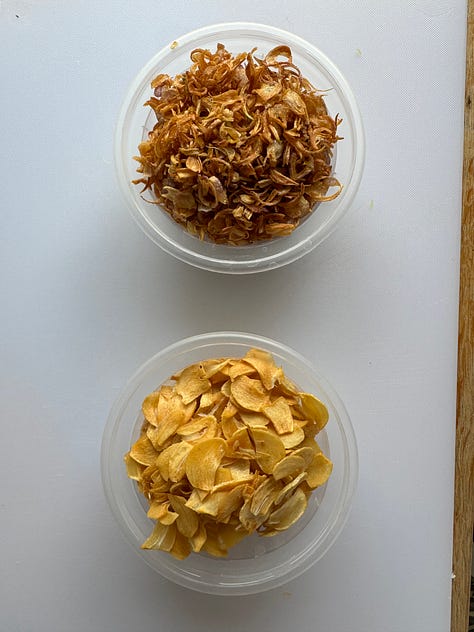
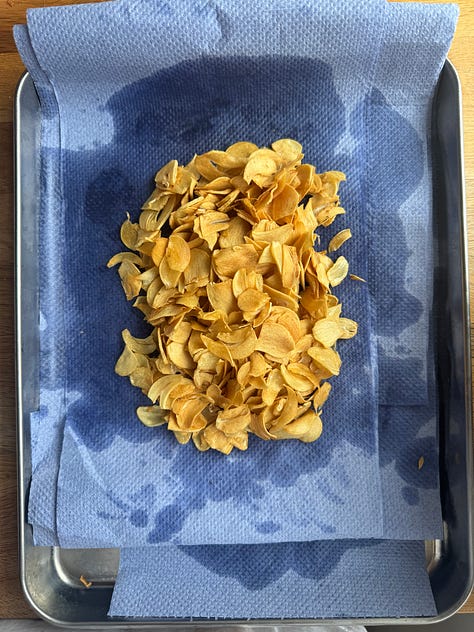
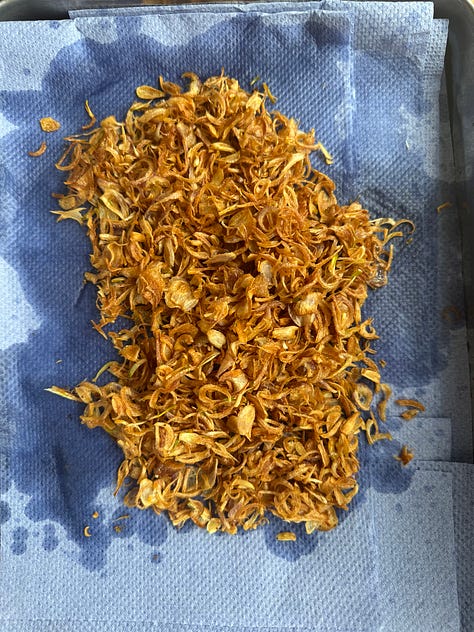
Seasoning: roasted chilli powder, lime juice, peanuts, fish sauce
All these seasonings (except for limes, which I usually have or can get by walking the 1 minute to my local off-license) keep for a long time. I make batches of roasted chilli powder by dry roasting big dried red chillies in a pan until 70% (surface area) blackened, then blitzing them in a spice grinder. Equally, store-bought chilli powder dry-toasted in a pan until smoky would also work.
As for the peanuts, I buy these from my local SE Asian grocer (Starnight, Hackney), which means I can just add a tablespoon as a topping without needing to roast whole nuts or chop/blitz them. They last a very long time in the pantry, so I always have them on hand.
The assembly
In case you got lost in the above medley, I’ve jotted down the recipe and process below.
Recipe (for 1 serving)
2x cups of chicken stock
150g seasoned minced pork
80g of dried noodles of choice
3 or so large spring green leaves (or something similar like pak choi, chard, etc)
1 tsp fried shallots + 1 tsp fried garlic
1 tsp roasted peanuts
A palmful of coriander leaves
Fish sauce, lime juice, roasted chilli powder to taste (I use about 1 tbs fs, 1.5 tbs lime, 1 tsp chilli powder)
Set a saucepan on medium heat and put 2x frozen blocks of stock in there to reheat.
Meanwhile, in another saucepan of boiling water, add one portion (about 150g) of seasoned pork mince, cook until done, then set aside. Cook dried noodles in the same pan until done. At the same time, blanch or steam (like I do) greens using the same pot. Set both noodles and greens aside.
Add cooked noodles, pork mince and greens to a bowl. Pour in hot stock. Top coriander, fried shallots and garlic. Season with fish sauce, lime juice, and chilli powder.
As I reach the end of this piece, something tells me that the philosophy behind this approach to home cooking is not all that it seems. Surely, any cooking methodology where convenience is the paramount consideration betrays the very essence of what food is all about. Sure, I kind of stumbled on this fairly basic approach to making noodle soup and the process gives me some time back in the evening to focus on other things. But what other things?
As I was pondering this question, I was reminded of a fable I read in Carolyn Steele's book Sitopia—an old-time story told by locals of the Aegean islands. I will leave it with you as a parting note.
“Much of it comes down to the story of an encounter between some wealthy Americans and an old Greek man sitting under a tree in an olive grove, sipping ouzo and staring out to sea. The Americans enquire from the Greek whether he owns the olive grove, and when he says that he does, they ask him why he doesn't hire people to harvest his olives and export the oil. 'And why would I do that?' asks the man, to which the Americans reply that he could get rich and do anything he likes. 'You mean,' says the man, 'that I could sit under this tree and sip ouzo at sunset?'“


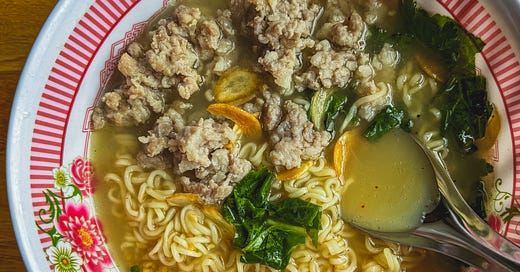




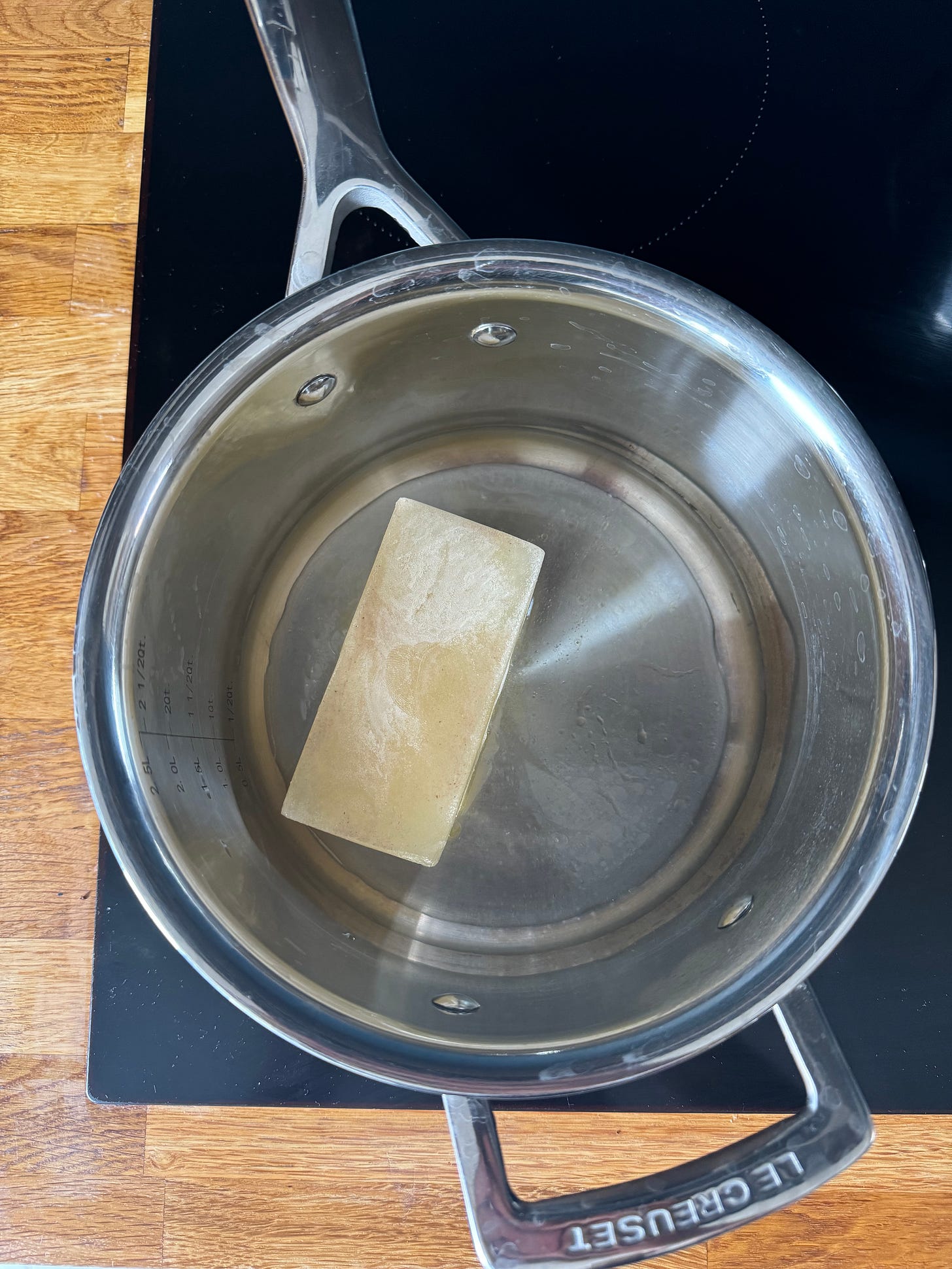

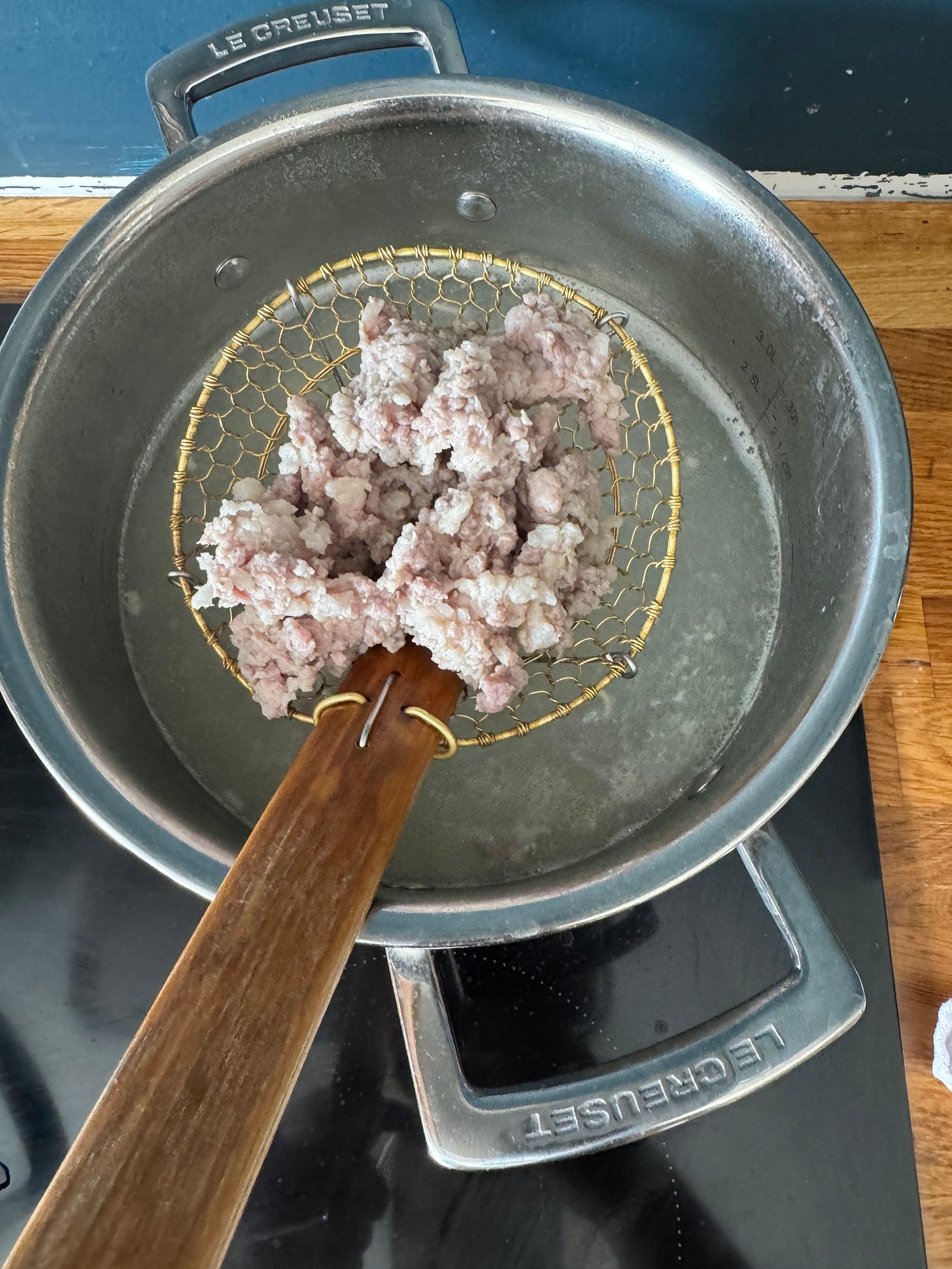
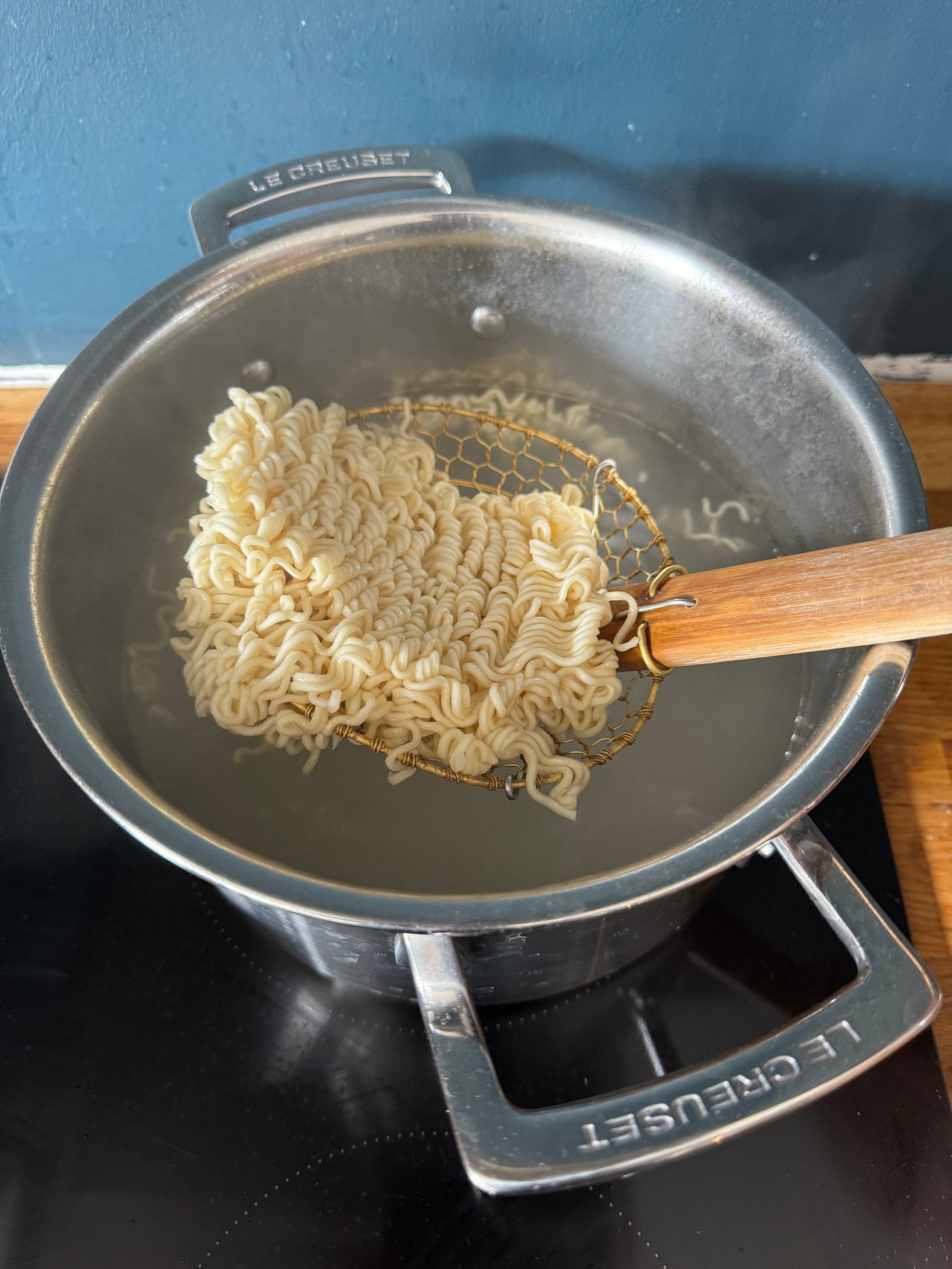
Great read.